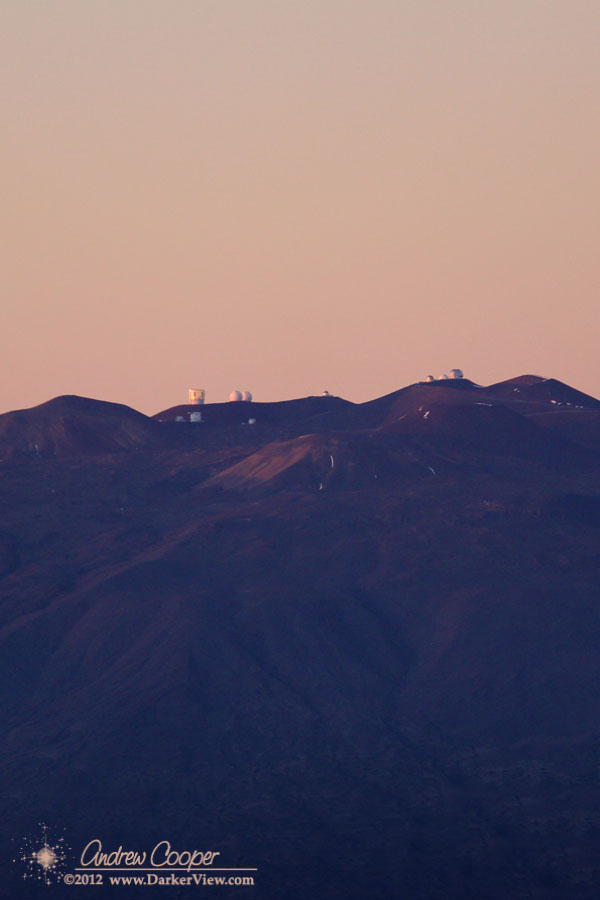
Category: Hawai’i
Exploring the islands
Postcard from the Universe – Rising Milky Way
Mauna Kea Observing
Yes, it is three in the afternoon and I am just waking up. That was the plan.
A night spent under dark Mauna Kea skies with a telescope. It has been much too long since I had a good night out with the ‘scope, it was time. A few items conspired to make it happen… Good weather, a note from the HR department that I was at maximum on accumulated vacation time, use it or lose it! Additionally, my friend and co-worker, Olivier Martin, was looking for a night of observing as well.
With a couple days of approved vacation I headed for the mountain.
A partly cloudy sky greeted us on arrival, high and heavy cirrus hid much of the blue. The forecast was for this to clear off during the first part of the night, not yet time to panic. Not wanting to deal with the crowd at the Mauna Kea VIS we hid out in a spot I found on one of the nearby back roads, a place where we would not be disturbed by any visitors through the night, a place that is completely dark.
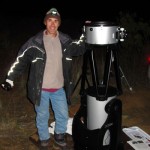
An Offering
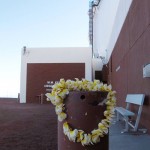
Early this week we were surprised to find a set of plumeria lei on one of the pillars in front of our building. Bright white and yellow, the scent of the flowers hanging heavy around the loading dock door. Quite a contrast in a world of dark red cinder and cold, a bit of the tropics that lie far below the summit.
Why would someone leave the lei at our door? A thank-you for what we do? A gentle protest at our presence on the mountain? I wonder as we drive down, lost in thought.
Venus Transit in the Press
Public awareness of a unique astronomical event, the Transit of Venus, is appearing. While avid sky-watchers have been anticipating this event for years, the general public is mostly unaware of the event.
This seems to be changing… A number of articles have appeared in the mainstream press this last week, from MSNBC to Fox News, providing information about the transit.
- Rare Venus transit of sun occurs in June – Fox News
- Your last chance to see rare Venus transit coming in June – MSNBC
- Rare Venus Transit of Sun Occurs in June – Discovery News
- Rare Venus Transit of Sun Occurs in June: Skywatching Travel Tips – Space.com
Yes, it is the same article on all of the sites, all apparently picked up from the Space.com site. There is some lesson here on the nature of corporate news today. In any case it is nice to see an astronomical event getting coverage. Any opportunity to get more astronomy onto the public stage is to be taken advantage of.
A transit is a less spectacular event, not exactly a total solar eclipse. It is quite interesting from an astronomical and historical standpoint. There are other articles, the transit is getting more press as the date approaches. In the run up to June 5th it will be interesting to see just what the public response to this event will be.
Poli’ahu i ke kapu
Poli’ahu is the goddess of snows who calls Mauna Kea her home. Poli’ahu i ke kapu, recently released by Hāwane, is a tribute to Poli’ahu, the divine snow goddess of Mauna Kea.
True, the sales of the song on iTunes go to KAHEA’s Hawaiian-Environmental Alliance Mauna Kea Legal Defense Fund. This is the same group that opposes telescopes on the mountain. The Enemy? Not really. In this case I respect those who stand up for what they believe, even if I disagree. KAHEA does needed work on other fronts across the islands.
Besides, it is a good song…
Mauna Kea Dusk
Mauna Loa Messier Marathon
I was determined to get out and use the telescope during the March new Moon, but had planned to go observing with the guys at Hale Pohaku on Mauna Kea. At the last minute I decided to accept an invitation from the Hilo group to observe from Mauna Loa instead. The guys planned on running a Messier Marathon, something I have enjoyed many times before.
Our usual observing location is Hale Pohaku, at 9,000ft on the south side of Mauna Kea. Hale Pohaku is a great observing site, high enough to be above the clouds, but well below the summit where thin air, wind and frigid temperatures can be miserable. It is impossible to do a complete Messier Marathon from Hale Pohaku, the bulk of Mauna Kea blocks too much of the northern sky making a few objects, most notably M52, difficult to impossible.
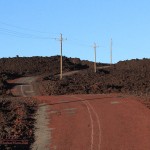
Venus Transit on Mauna Kea
A Venus Transit is a truly rare event. Transits occur in pairs eight years apart, with the next pair not occurring for another 120 years. The first event of the current pair occurred in 2004. Thus the next event will happen in June 2012. Considering the century long period between events, this is the last chance to witness a Venus transit during our lifetimes.
The 2012 event will be visible from the west coast of North America to Japan, China, Australia and Central Asia. For those wanting to observe the entire event from start to finish the choices narrow quite a bit. You have the choice of the Central Pacific, Japan, as well as Eastern China and Eastern Australia. This, of course, includes here in the Hawaiian Islands.
Many sky-watchers from North America will see only one choice if they wish to observe the event… the Big Island. The only place easily accessible by air, featuring excellent visitor accommodation, and an observing site that sits above the clouds that could so easily interfere with carefully laid plans. For the serious observer there is one obvious choice… Mauna Kea.
We saw the first signs of this well over a year ago. The tour companies that specialize in astronomy related travel, the folks that feature solar eclipse tours and similar events, began scouting Mauna Kea as a destination. Then the ads appeared, in Sky & Telescope magazine, Astronomy magazine, etc., “See the transit from Mauna Kea!” We had fair warning that this event was not going to pass peacefully.
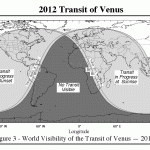
Visibility chart for the 2012 Venus transit, image credit: Fred Espenak/NASA
Some folks seem to think the crowd will be huge, a thousand people or more. I am not so certain, this does not have the general appeal of a total solar eclipse. The transit is something that will be of interest to amateur astronomers and some interested segments of the public. I personally expect hundreds of people coming to Mauna Kea to view the transit, not thousands.
However many folks do ascend the mountain for this event, we have begun putting plans in place to handle it. Various groups have met to do a bit of planning. Most significantly, those in charge of managing the mountain, The Office of Mauna Kea Management, are putting a few measures in place. As usual, expect to stop at the Mauna Kea Visitor Information Station on the day of the transit. But this day there will be a few differences…
- All available MKSS staff will be on duty. All of the Mauna Kea rangers and visitor station staff will be helping make sure assistance is available to visitors when traveling to the high altitude environment of the summit.
- Access to the mountain will be controlled for the day, a gate at the VIS allowing access for official vehicles only.
- A free shuttle will run from the VIS to the summit. The Mauna Kea tour companies providing the vehicles and drivers.
- Solar telescopes and video monitors will be set up at the VIS to allow safe viewing. Staff will be available to answer questions and assists with the equipment.
- Several other locations on the island will be setup for viewing the transit with solar telescopes and staff. Expect these to include ‘Imiloa, Keck HQ in Waimea, and some possible other locations.
All of these plans are somewhat preliminary, details may change as the date approaches and final arrangements are made. I will attempt to post what I know here on Darker View.
Myself? I plan to observe the event from the summit. Set up behind Keck with a solar telescope to photograph the transit. We plan to set up a live feed of the transit for use by other sites, and available to viewers across the internet.
Holoholokai
At the very north end of the Mauna Lani resort complex, just beyond the gates into The Fairmont Orchid is a very nice public access to the coastline. With well maintained facilities, this park attracts local and tourists alike to the water. There are full bathrooms, a fresh water shower, picnic tables and barbecue grills to use amongst a rich lawn and pleasant shade trees. The coast here is a picturesque combination of blue water and black volcanic rock jutting into the sea. The parking is limited to a couple dozen spots just behind the park. The site can be used equally well by divers or experienced snorkelers with a rich coral reef just offshore the beach here.
The entry here is rough cobble and rock, care must be taken to scout a course through the many offshore rocks that complicate swimming to and from the beach. When the seas are calm, there should be little if any trouble getting to and from shore, do not attempt this area if there is any substantial surf to deal with.
View Larger Map
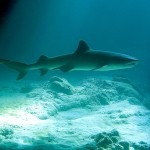 Whitetip Reef Shark (Triaenodon obesus) in a cave at Holoholokai, photo by Deborah Cooper
Whitetip Reef Shark (Triaenodon obesus) in a cave at Holoholokai, photo by Deborah Cooper
Reaching the site is fairly easy, following signs to the beach and to the petroglyphs through the Mauna Lani resort. Turn into the Mauna Lani resort from the Queen Ka’ahumanu highway at the obvious grove of tall palms surrounding the entrance. A little over a mile across the lava flows will bring you to a large roundabout (traffic circle in American). Turn on the first exit from the circle, heading north through the condominiums and town homes. A couple miles more will bring you to the entrance to the Fairmont Orchid. Just before the entrance a right turn leads down a paved road to the park.
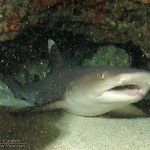 A Whitetip Reef Shark (Triaenodon obesus) under a ledge at Holoholokai
A Whitetip Reef Shark (Triaenodon obesus) under a ledge at Holoholokai
Once into deep water the snorkeling or diving is as good as anywhere along the Kohala Coast, the same reef divers can enjoy at the Puako sites just north. The depth remains quite shallow until about 50 yards offshore where a series of steps can be found, the first dropping to 15-25ft and another just past this dropping yet further. The vertical walls of these steps are rich in coral and life. The shallow step provides the best place for snorkeling, while divers will quickly head for deeper water. Eels, octopus and other rich marine life are all to be seen here.
There are several very nice caves for divers here. Trending south from the entry area, one will encounter a surge channel in the coral. Two nice caves are found along this small canyon. The better of the two is on the north side where a low entrance at the base of the wall leads to a 40 foot diameter chamber with a large skylight. Sleeping white tip sharks are common in the caves and overhangs here, particularly first thing in the morning.
The parking lot also serves as a trail head for a three-quarter mile walk to the Puako Petroglyphs, a large collection of ancient Hawaiian rock art that is found in photos and guidebooks all across the islands.
Holoholokai makes for a nice beach experience with a pleasant park and good access to the water. Worth considering if looking for a place to get to the water amongst the resorts of the Kohala Coast.


